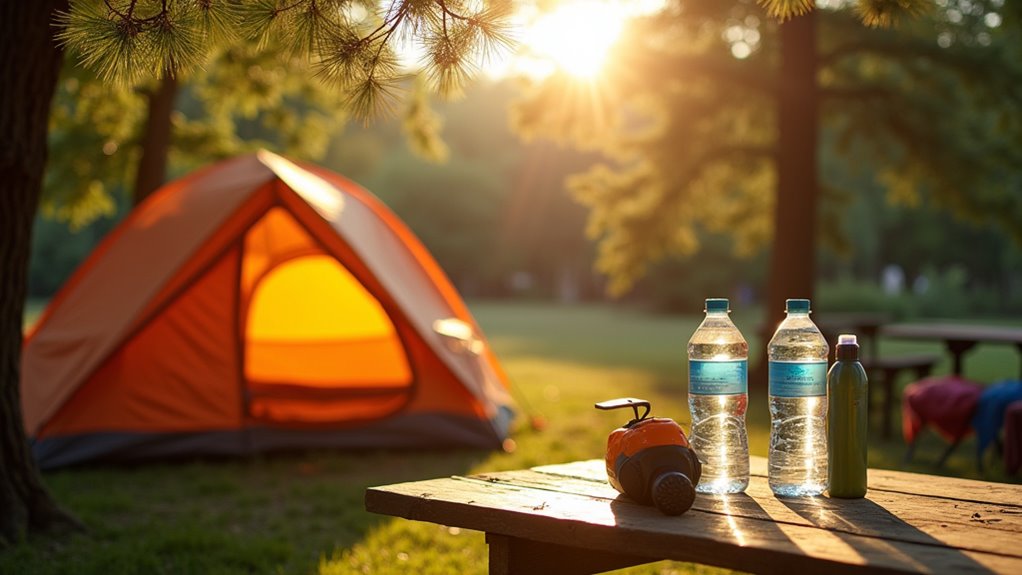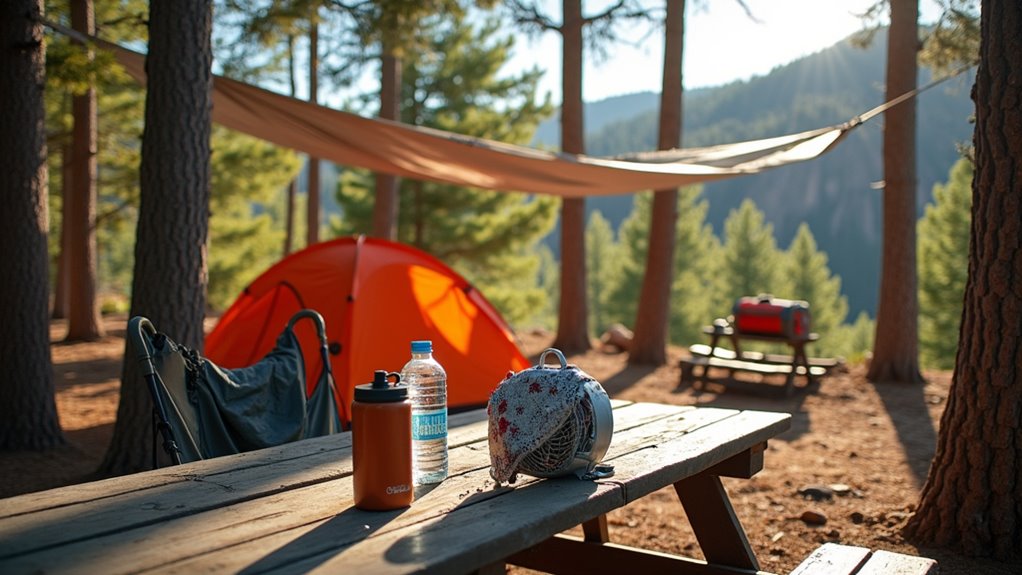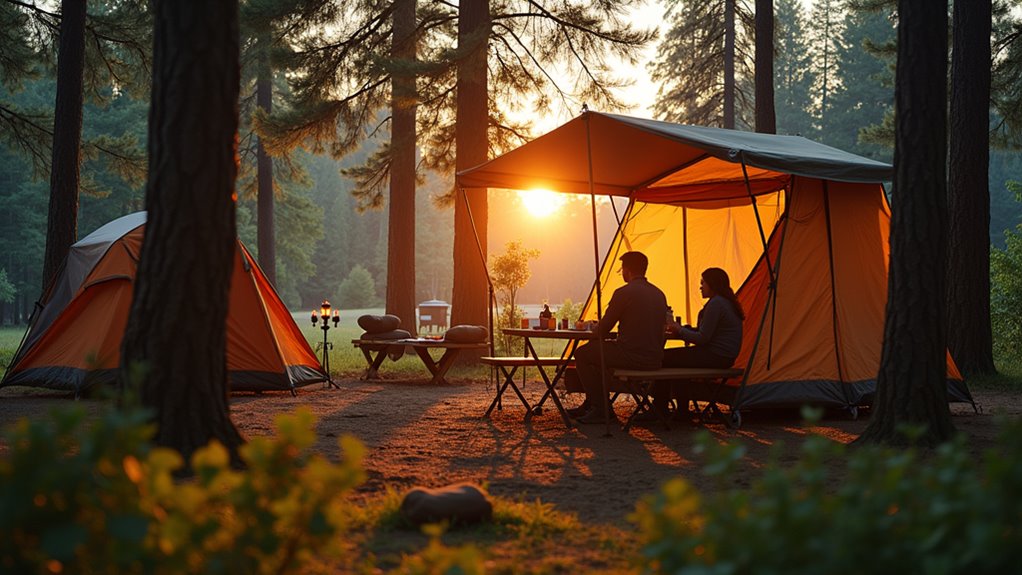Physical Address
304 North Cardinal St.
Dorchester Center, MA 02124
Physical Address
304 North Cardinal St.
Dorchester Center, MA 02124

Want to enjoy summer camping without melting or going broke? These five game-changing tips will revolutionize your hot-weather adventures forever.
While you might think summer camping means unbearable heat and endless bugs, it’s actually the perfect time to enjoy longer days and warmer nights outdoors. You don’t need expensive gear or fancy equipment to stay comfortable when temperatures soar. With a few smart strategies for cooling down, staying hydrated, and protecting yourself from the elements, you’ll discover that summer camping can be both affordable and enjoyable. These five essential tips will transform your hot-weather adventures into memorable experiences.

When temperatures soar during summer camping trips, you’ll need proven strategies that don’t break the bank to stay comfortable. Set up camp in shaded areas under trees or use inexpensive tarps to create your own shade. Pack a spray bottle filled with water for instant cooling relief throughout the day. Choose light-colored, loose-fitting clothing that reflects heat rather than absorbing it.
Freeze water bottles before your trip – they’ll keep food cold and provide invigorating drinks as they melt. Take advantage of natural cooling by camping near water sources like lakes or streams. Schedule strenuous activities during cooler morning and evening hours. Consider battery-powered fans for your tent, which cost less than portable air conditioners but provide effective air circulation.
While staying cool matters, proper hydration becomes your most critical survival skill during summer camping adventures. You’ll need more water than you think – aim for at least one gallon per person daily in hot weather. Don’t wait until you’re thirsty; sip consistently throughout the day.
Plain water isn’t enough when you’re sweating heavily. You’re losing essential electrolytes that plain H2O can’t replace. Mix affordable electrolyte powder into your water bottles, or create your own solution with a pinch of salt and a squeeze of lemon. Sports drinks work but cost more.
Monitor your urine color – pale yellow means you’re properly hydrated. Dark yellow signals dehydration. Pack extra water containers and know nearby water sources for refills. Having a stable camping table makes it easier to organize your hydration supplies and prepare electrolyte drinks throughout the day.

Summer’s intense UV rays and unpredictable weather patterns can turn your camping trip into a painful ordeal if you’re unprepared. You’ll need broad-spectrum SPF 30+ sunscreen, reapplying every two hours and after swimming. Don’t forget often-missed spots like ears, feet, and lips. A wide-brimmed hat and UV-protective clothing offer affordable, reliable protection.
Check weather forecasts before departing and pack layers for temperature swings. Lightweight rain gear beats getting soaked, and it doubles as wind protection. Seek shade during peak sun hours (10 AM-4 PM) by setting up camp near trees or using a tarp.
Watch for heat exhaustion signs: dizziness, nausea, and excessive sweating. If storms approach, avoid open areas and tall objects. Your preparation prevents painful sunburns and dangerous weather exposure. If you’re planning water activities during your camping trip, consider whether renting or buying a boat makes more sense for your fishing adventures.
Since high temperatures can spoil food within hours, you’ll need smart strategies to keep your meals safe and fresh.
Hot weather turns fresh food dangerous fast, so preparation and proper cooling techniques become essential for preventing foodborne illness during outdoor activities.
Pack two coolers – one for drinks, one for food. Drinks get opened frequently, letting cold air escape. Keep coolers in shade and cover with reflective emergency blankets or wet towels. Freeze water bottles beforehand; they’ll act as ice packs and provide cold drinks later.
Pre-freeze meat and cook it first when thawed. Pack non-perishables like nuts, crackers, and dried fruits as backup options.
Use a food thermometer to check meat reaches safe temperatures.
Don’t leave perishables out longer than one hour when it’s above 90°F.
When in doubt, throw it out.
Consider using bear-proof containers or hanging food properly to protect your supplies from wildlife that might be attracted to your campsite.

As temperatures rise, wildlife becomes more active in their search for food and water, making your campsite an attractive target. You’ll need smart strategies to coexist safely while protecting yourself from pesky insects.
Follow these essential protection measures:
Keep your campsite clean, dispose of waste properly, and you’ll minimize unwanted wildlife encounters. For camping enthusiasts looking to add adventure to their summer trips, consider trying rock climbing as an exciting outdoor activity that pairs perfectly with camping.
You’ve got your summer camping survival toolkit now – think of these tips as your shield against Mother Nature’s fiery temper. Don’t let the heat turn your adventure into a nightmare; instead, you’ll dance with the sun while staying cool, hydrated, and protected. Your wallet won’t take a beating either, since most strategies use common sense over costly gear. Now get out there and make those summer memories without melting!